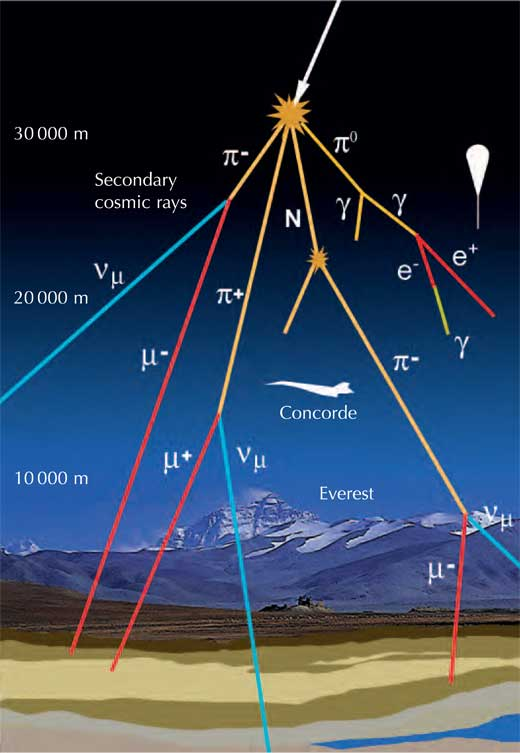#fermilab

Muon Tau
Mass: 105.658 MeV/c^2 Mass: 1776.86 MeV/c^2
Charge: -1 e Charge: -1 e
Spin: ½ Spin: ½
Color: None Color: None
Antiparticle: antimuon Antiparticle: antitau
The muon and tau are second and third generation, respectively, leptons and fermions. There are a total of 6 leptons in the standard model. The electron, muon, and tau are the three which have electric charge while the others, the neutrinos, do not. Both the muon and tau are much more massive than the electron and decaydue to the weak interaction. The muon decays on average 2.2 microseconds (2.2*10^-6 s) into usually an electron and two neutrinos of different types. The tau decays much quicker in 2.9 * 10^-13 seconds into hadrons(composite particles made of two or more quarks, e.g. proton). The tau is the only lepton able to decay into hadrons because it is the only one with sufficient mass.

The muon was discovered by Carl D. Anderson and Seth Neddermeyer in 1936 by studying cosmic radiation and observed particles which deflecteddifferently than electrons in a magnetic field. The radius of deflection depends on mass and charge. Since the charge is the same the difference must be accounted through a greater mass.
The tau was theoretically predicted in 1971 by Yung-su Tsai and experimentally detected between 1974-1977 at the Stanford Linear AcceleratorandLawrence Berkeley National Laboratory.
Probably the most well known experiment that involves muons is the Muon g-2 (”g minus 2″) experiment at the Fermi National Accelerator Laboratory or Fermilab. The goal is to measure the magnetic dipole moment at a very high precision because there is a slight deviation from g=2 (hence g minus 2) known as the “anomalous” part predicted by the Standard Model theory. A large enough difference between the experimentally measured and theoretically determined values could point to the existence of more undiscovered subatomic particles. Read more about the Muon g-2 experiment below:
Sources:(1)-(2) & Image 2 -(3)- Image 1
Joaquin, Lucas and Bear #familyday #kids #fermilab #saturday #labrador #pets (at Fermi National Accelerator Laboratory)
Post link
This one is better #labrador #gosox #arnomayorga #fermilab #pets #saturday #familyday (at Fermi National Accelerator Laboratory)
Post link
Architecture #fermilab #Structure #architecture #saturday #familyday (at Fermi National Accelerator Laboratory)
Post link
Fermin National Accelerator #fermilab #Structure #architecture #familyday (at Fermi National Accelerator Laboratory)
Post link
Family Day #fermilab #saturday #lafamilia #familia #kids #fun #Family #familyday (at Fermi National Accelerator Laboratory)
Post link
We are in FermiLab #saturday #kids #fermilab #dogs #pets #lake #wetdog (at Fermi National Accelerator Laboratory)
Post link






